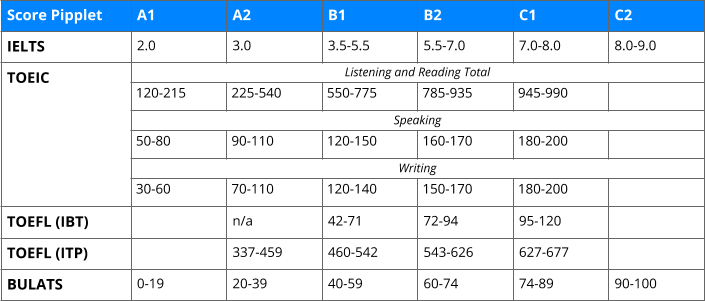Converting Pipplet Scores
Pipplet Team • 9 décembre 2019
Pipplet is based on the CEFR and as a result, our scores are universally applicable.
There is a broad range of language tests that exist today, many with their own grading scales, and others which are based directly on the CEFR. For those that are based on the CEFR, the scores are easily comparable, but for the tests that have their own grading scales, there are usually conversion systems.
In this article, we will describe various conversion systems that allow you to assess and place your candidates according to their scores on other tests.
It is important to note that an individual’s language competency evolves frequently, whether strengthening or weakening. Therefore, it is important to link scores to the date on which the test was taken.
Pipplet and English Language Tests
Given that numerous English language tests exist today, it is not easy to compare scores as it is difficult to provide a perfect equivalent among tests of varying formats and styles. Furthermore, these tests often target specific audiences and emphasize certain skills over others.
Having said that, and even though there is often no consensus between linguists, it is still possible to establish a system of conversion between the tests. However, it is important to keep in mind that a candidate’s performance can vary from test to test depending on their strengths and method of preparation.
Pipplet and tests in other languages
After the establishment of the Common European Framework of Reference for Languages in 2001, the majority of education ministers and member states of the EU modified their language certifications. As a result, certifications such as the DELF/DALF (for French), the DELE (for Spanish), the CELI (for Italian), and the Goethe-Zertifikat (for German) all converted to the 6 levels of the CEFR.
Other countries outside the EU, such as Turkey, Russia, and South Korea decided to adapt their national tests as well.
For scores from these tests, the conversion of scores occurs directly through Pipplet.
Languages with Non-Latin Writing Systems
The CEFR is structured around evaluating action based competencies or the ability to carry out a task in a language. Therefore, it is not tied to any one language. However, since the framework was initially based on European languages, it is not always easy to apply it to other languages, especially those that use non-Latin characters.
For a learner coming with the background of a Latin language, the first step is to learn the writing system. Consequently, their ability to perform depends on their proficiency and command over the writing system. This is especially true for Chinese and Japanese where knowledge of vocabulary becomes integral to measure the competency of the language.
For Japanese, the existing language exam is the JLPT or the Japanese Language Proficiency Test which consists of five levels of proficiency. The creators of the CEFR have determined no correlation between their exam and the levels of JLPT, which is where the difficulty lays.
According to independent linguists, the most precise estimate would be to place the lowest level, N5, between A1 and A2 of the CEFR, and the highest level, N1, in correspondence with level C1 of the CEFR (or C1+ according to some linguists).
The primary reference for Mandarin
is the Chinese language evaluation, HSK. This test is comprised of six levels.
The Confucian Institute proposed a system based primarily on the quantity of vocabulary required for each level. According to the creators of the tests, the level HSK1 corresponds with A1, HSK2 to A2, and so on to HSK6 which corresponds with C2.
However, this point of view is contested by experts in certain European countries. Therefore, in Germany, Italy, and France, HSK2 instead corresponds with A1 and HSK6 corresponds with B2 of the CEFR.
There is no consensus among linguists of different countries regarding the correlation between the levels of the HSK and the CEFR.
Nevertheless, Pipplet suggests referring to the conversion proposed by European experts.
Conclusion
The Pipplet language test score is easily comparable with all tests based on the six levels of the CEFR. On the contrary, for exams based on their own proficiency levels, it is quite difficult to establish a perfect conversion.
In any case, evaluating a language is not an exact science. It is always easier to compare levels within the same test as the criteria taken into account and the evaluation methods have a notable effect on the final score. It is also necessary to keep in mind the margin of error linked to the conditions in which the test was taken, as well as the fact that a language assessment is always an approximation.
Related stories











